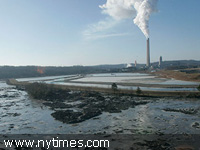EPA to Act on Coal Ash Problem
 GLOBE-Net - The phrase ’This should never have happened’ seldom gives comfort after a natural disaster or preventable calamity, but that is exactly what the U.S. Environmental Protection Agency is saying in response to last year’s massive coal ash spill at a Tennessee Valley Authority facility in Kingston, Tennessee.
GLOBE-Net - The phrase ’This should never have happened’ seldom gives comfort after a natural disaster or preventable calamity, but that is exactly what the U.S. Environmental Protection Agency is saying in response to last year’s massive coal ash spill at a Tennessee Valley Authority facility in Kingston, Tennessee. The EPA has laid out new efforts to prevent future threats to human health and the environment. The agency’s plan includes measures to gather critical coal ash impoundment information from electrical utilities nationwide, conduct on-site assessments to determine structural integrity and vulnerabilities, order cleanup and repairs where needed, and develop new regulations for future safety.
All of which should have been going on for years if the EPA was doing its job properly, some have argued.
The December 2008 release of coal ash from TVA’s Kingston, Tennessee facility flooded more than 300 acres of land, damaging homes and property. Coal ash from the release flowed into the Emory and Clinch rivers, filling large areas of the rivers and killing fish. TVA cost estimates for the clean-up range between $525 million and $825 million, which does not include long-term cleanup costs.
In the wake of the Tennessee it was found that more than 1,300 similar dumps existed across the United States - most of them unregulated and unmonitored. Collectively they contain billions more gallons of fly ash and other by-products of burning coal for energy.
Many of these dumps, which can reach up to 1,500 acres, contain heavy metals like arsenic, lead, mercury and selenium, which the Environmental Protection Agency already knew to be a threat to water supplies and human health.
Yet they are not subject to any federal regulation or inspection, which could have prevented the Tennessee spill. Nor is there monitoring of the effects these sites on the surrounding ecosystems.
In fact, coal ash is being used throughout the country for construction fill, mine reclamation and other “beneficial uses” including oddly enough for agricultural uses to improve the ability of soils to hold water, despite a 1999 E.P.A. warning about high levels of arsenic.
Even more interesting, the EPA is in a partnership with the American Coal Ash Association, the Utility Solid Waste Activities Group, the U.S. Department of Energy, U.S. Department of Agriculture-Agricultural Research Service, U.S. Federal Highway Administration, and Electric Power Research Institute to help promote the beneficial use of Coal Combustion Products (CCPs) and the environmental benefits that result from their use.
The industry has promoted the reuse of coal combustion products because of the growing amount of them being produced each year - 131 million tons in 2007, up from less than 90 million tons in 1990. The increased tonnage is due in part to the fact that new pollution prevention technologies are capturing more of the contaminants that used to spew out of smoke stacks and they are being held in the form of solid wastes in large containment dumps.
There have been endless studies confirming that ash can dumps can leach toxic substances into surrounding eco-systems that can cause cancer, birth defects and other health problems in humans, and can decimate fish, bird and frog populations in and around ash dumps.
State regulations for coal ash vary widely. Some states, like Alabama, do not regulate it at all. In Texas, coal ash is not considered a hazardous waste, so there are no groundwater monitoring or engineering requirements for utilities that dump the ash on site, as most utilities do.
One of the factors contributing to the confused mixture of state level regulatory regimes is the lack of a consistent national standard. The EPA has been studying the problem for close to 30 years, but still has yet to rule that fly ash is a hazardous waste, which would make it subject to tighter regulatory controls. According to one report, the coal industry lobbied successfully against EPA action, arguing that the extra cost to the industry would exceed $5 billion a year. In 2007 the Department of Energy estimated that it would cost $11 billion a year.
What it might cost if the EPA decides to act after it carries out its announced due diligence is anyone’s guess.
Another coal ash spill similar to that which occurred in Tennessee could happen again. When and if that happens, it is hoped that EPA Administrator Lisa Jackson will have more positive news to report than “This should never have happened.”
For more information on coal ash including its beneficial uses, visit this EPA website. A New York Times video on the Tennessee oil spill is available at this site.
You can return to the main Market News page, or press the Back button on your browser.

